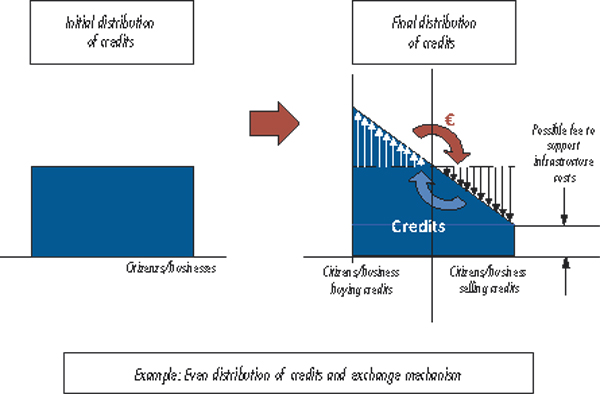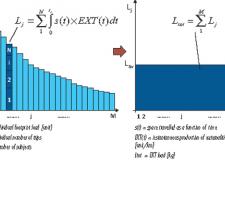
Vito Marcolongo and Marco Troglia,
In Europe particularly, several cities have sought to improve the efficiency and sustainability of their transport systems by introducing mobility restrictions or measures intended to promote modal shift such as parking tariffs and/or road/cordon pricing.
However these solutions pose major problems, namely: inequality of flat rates; imperfection of the payment schemes in relation to targeted reductions in externalities; implementation and operational costs (which can be very high as such solutions need terrestrial infrastructures); and reliability.
The Mobility Credit Model (MCM) is a demand management solution based on permissions instead of restrictions which is intended to properly and fully overcome the four barriers identified above.
MCM is based on a new concept for urban mobility: that a change in driving behaviour can help maintain our cities as attractive places to live in and to visit, ensuring that they can continue to function as successful engines of the economy.
The Mobility Credits Model
Underpinning MCM is the provision of a compelling reason for travellers to adjust their behaviour and choices. It is not enough that travellers simply understand the need for change; they must also look to reduce their mobility-related footprints. This means that it is necessary to create a behavioural context where travellers and transport operators can experience the effects of changing attitudes and choices in mobility.The MCM allows the creation of this context within a range of possible implementations, from a pedagogic tool to a mandatory demand management scheme.
The mechanism of this context is to set a quantitative target of Sustainable Environmental Footprint (SEF) - that is, an allowable threshold for each type of externality, which might be energy consumption or CO2 production, to make the approach path to the target measurable (for example, how much CO2
Table 1: The four basic pillars of the Mobility Credit Model
1. Set the target
In the case of a metropolitan area, this would require definition of a suitable SEF. The general concept of MCM addresses all externalities associated with transport, from greenhouse gases to noxious emissions, congestion, street occupancy and noise.
2. Distribute credit budgets
Convert the SEF into a 'total amount of credits' which is distributed to all travellers and transport operators in the local area using various schemes. A base scheme might distribute an equal amount of credits to each traveller/operator but distribution can be based on other criteria as deemed appropriate.
3. Set the rules
Define a set of rules for use of the credits. The rules will imply a consumption of credits based on actual behaviour of travellers (both private citizens and professional network users) including the modes of transport, the characteristics of vehicles (vehicle size and model, engine capacity/characteristics and so on), levels of emissions of CO2 and other pollutants during actual conditions of use (which can depend on a large number of factors such as congestion levels and local commercial speed(s), time and length of trip, path taken across different areas of the city, origin and destination, availability of transport alternatives, people versus freight movements, resident versus non-resident movements, special needs, multimodality and so on). Accordingly, the speed of consumption of the initial credit grant will depend heavily on the mobility choices of the traveller.
4. Exchange
Allow travellers with a negative balance of credits to buy extra credits from other travellers who are credit-positive.is not produced on account of a different mobility choice) and to apply a driving force (either an incentive or an obligation) to encourage movement from the existing to the target situation. Accordingly, the MCM has four basic pillars and these are set out in Table 1.
The basics of the MCM are illustrated in Figure 1. This shows that the total environmental footprint of any given urban location (the dark blue area of the right-hand rectangle) can be considered to be the sum of the environmental footprints of each citizen or business. Figure 2 shows how the total environmental footprint, when converted into 'credits', can for example be distributed evenly across all citizens and businesses. Those travellers with a negative balance of credits shall buy extra credits from other travellers who are credit-positive. The total number of credits remains the same and within the SEF defined by the demand management systems.
Key features
The MCM has some key features.An Electronic Footprint Wallet describes the environmental footprint related to the mobility of people and goods when translated into 'credits' that will become the common currency to be spent within the assigned budget limits.
Travellers' awareness is improved since, due to the fact that travellers will not have an unlimited number of credits, they are requested or encouraged to optimise their consumptions and modify their mobility profiles.
Implementation
The MCM concept was first simulated in the Municipality of Genova in 2005, supported by a grant from the Fondazione Italiana Accenture. This feasibility study considered mandatory adoption of an adaptive demand management policy.
According to the simulation the number of car journeys was reduced by 12-27 per cent; PM10 emissions were reduced by 5-17 per cent; and those of CO2 fell by 6-22 per cent. These figures include travellers shifting to other modes, changing their times of travel or deciding not to travel. They can also be read as an equivalent reduction of externalities in urban areas.
The scheme generated annual net incomes for the Municipality of Genova of €10-25 million, which can be redistributed to the population, either to finance the implementation and upkeep of MCM or to update/upgrade public transport. The simulation in Genova involved around 350,000 vehicles. It cost approximately €5.5 million, not including the purchasing and installation of onboard units, and cost around €3 million a year to run.
Currently MCM is being developed by the Democritos project, which is taking place under the
Democritos is focused on demand management based on permissions in urban areas and the subjects of the MCM are mainly private car owners. The project's goal is to establish an exhaustive framework of a Mobility Credit Platform (MCP) which is described in Table 2.
By the end of the project, municipalities and regional authorities within the consortium will have a sound basis upon which to decide upon the adoption of the MCP as a means to influence travellers' choices in order to reduce the environmental footprints. Consultancies and technology providers, meanwhile, will have a clear understanding of the concept and of the associated technologies needed to assist public administrators, municipalities, enterprises, interest groups, communities and citizens in and outside Europe to implement the platform.
Table 2: The Mobility Credits Platform
The framework for an MCP being developed by Democritos will look at:
•Further enhancing the theoretical framework addressing medium- and long-term effects (relocation of industrial, commercial and residential activities, inflation in prices of goods and services, local competitiveness, effect on tourism and so on);
•Different ways to implement the four conceptual pillars of MCM (theoretical schemes to define the charge area and to measure "the sustainable load"; load-credits ratio; alternative policies to an even distribution of credits; rules; exchange models);
•How the model could spur innovation in individual transport means through a positive selective pressure to induce the use of low-polluting, low-consumption and smaller vehicles;
•The implications of different technology scenarios (automotive; other transport means; electronics; sensors; and mobile communications) and how they can fit into the model;
•Social awareness and concerns related to applying such pervasive monitoring (including trade-offs between security and environmental benefits













